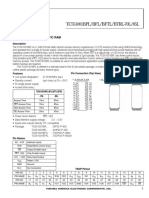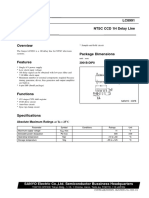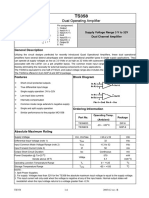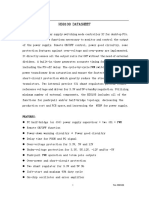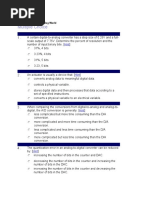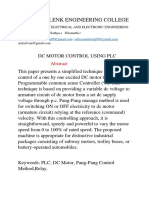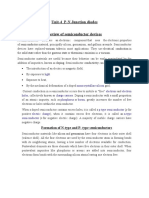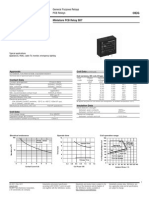TTP 224
TTP 224
Uploaded by
Sarah Joy ManimtimCopyright:
Available Formats
TTP 224
TTP 224
Uploaded by
Sarah Joy ManimtimOriginal Description:
Original Title
Copyright
Available Formats
Share this document
Did you find this document useful?
Is this content inappropriate?
Copyright:
Available Formats
TTP 224
TTP 224
Uploaded by
Sarah Joy ManimtimCopyright:
Available Formats
Preliminary TTP224-ASD
4 KEY TOUCH PAD DETECTOR IC
GENERAL DESCRIPTION
The SP224-ASD is capacitive sensing design specifically for touch pad controls. Stable sensing
method can cover diversity conditions. Human interfaces control panel links through non-conductive
dielectric material. The main application is focused at replacing of the mechanical switch or button.
The ASSP can independently handle the 4 touch pads with 4 direct output pins.
FEATURES
Operating voltage 2.5V~5.5V
Built-in regulator with external enable/disable option
Operating current, @VDD=3V no load
At low power mode typical 2.5uA
At fast mode typical 9.0uA
@VDD=3V The response time about 100mS at fast mode,
200mS at low power mode
Sensitivity can adjust by the capacitance(0~50pF) outside for each touch pad
Provides Fast mode and Low Power mode selection by pad option(LPMB pin)
Provides direct mode or toggle mode、CMOS output or open drain output、
active high or active low by pad option(TOG/AHLB/OD pin).
Provides one output pin TPQ0D that has no diode protection, active low
Have the maximum on time 120sec/64sec/16sec/infinite by pad option(MOT1, MOT0 pin)
After power-on have about 0.5sec stable-time, during the time do not touch the key pad,
and the function is disabled
Auto calibration for life, and the re-calibration period is about 4.0sec, when key has not be
touched.
APPLICATION
Wide consumer products
Button key replacement
09’/06/15 Page 1 of 10 Ver :0.0
Preliminary TTP224-ASD
BLOCK DIAGRAM
TP0 Sensor &
TP1 Sensor oscillator Reference TPQ0
TP2 circuit detecting circuit Output TPQ1
TP3 mode TPQ2
& TPQ3
driver
circuit
LPMB Timing counter & TPQ0D
MOT0
function option
MOT1
control circuit Touch detecting
REGEN
circuit
System oscillator
circuit TOG
AHLB
Key-on & timing OD
Regulator control SM
VREG
circuit
PIN DESCRIPTION
Pin No. Pin Name Type Pad Description
1 TP0 I/O Touch pad input pin
2 TP1 I/O Touch pad input pin
3 TP2 I/O Touch pad input pin
4 TP3 I/O Touch pad input pin
5 AHLB I-PL Output active high or low option, default:0
6 VDD P Positive power supply
7 VREG P Internal regulator output pin
8 TOG I-PL Output type option, default:0
9 LPMB I-PL Low power/fast mode option, default:0
10 MOT1 I-PH
Key maximum on time option, default:1
11 MOT0 I-PH
12 VSS P Negative power supply, ground
13 REGEN I-PH Internal regulator enable/disable function option, default:1
14 OD I-PH Output open-drain option, default:1
15 SM I-PH Single/multi key option, default:1
16 TPQ3 O Direct output
17 TPQ2 O Direct output
18 TPQ1 O Direct output
19 TPQ0 O Direct output
20 TPQ0D OD Open Drain output(have no Diode protective circuit), active low
Note:Pin Type
I =>CMOS input only I-PH =>CMOS input and pull-high resister
O =>CMOS push-pull output I-PL =>CMOS input and pull-low resister
I/O =>CMOS I/O OD =>Open drain output, have no Diode protective circuit
P =>Power / Ground
09’/06/15 Page 2 of 10 Ver :0.0
Preliminary TTP224-ASD
ELECTRICAL CHARACTERISTICS
‧Absolute Maximum Ratings
Parameter Symbol Conditions RATING Unit
Operating Temperature Top ─ -20℃ ~ +70℃ ℃
Storage Temperature TSTG ─ -50℃ ~ +125℃ ℃
Supply Voltage VDD Ta=25°C VSS-0.3 ~VSS+6.0 V
Input Voltage Vin Ta=25°C VSS -0.3 to VDD+0.3 V
Human Body Mode ESD ─ KV
Note: VSS symbolizes for system ground
‧DC/AC Characteristics:(Test condition at room temperature=25℃)
Parameter Symbol Test Condition Min. Typ. Max. Unit
Operating Voltage VDD 2.5 - 5.5 V
Internal Regulator Output VREG 2.2 2.3 2.4 V
Operating Voltage VDD 2.0 5.5 V
(internal regulator disable)
Operating Current Iop1 VDD=3V 2.5 uA
(no load) At low power mode
VDD=3V 9 uA
At fast mode
Input Ports VIL Input Low Voltage 0 - 0.2 VDD
Input Ports VIH Input High Voltage 0.8 - 1.0 VDD
Output Port Sink Current IOL VDD=3V, VOL=0.6V - 8 - mA
Output Port Source Current IOH VDD=3V, VOH=2.4V - -4 - mA
Input Pin Pull-high Resistor RPH VDD=3V, 30K ohm
Input Pin Pull-low Resistor RPL VDD=3V, 25K ohm
Output Response Time TR VDD=3V, At fast mode 100 mS
VDD=3V, At low power mode 200 mS
09’/06/15 Page 3 of 10 Ver :0.0
Preliminary TTP224-ASD
FUNCTION DESCRIPTION
1. Sensitivity adjustment
The total loading of electrode size and capacitance of connecting line on PCB can affect the
sensitivity. So the sensitivity adjustment must according to the practical application on PCB. The
TTP224-ASD offers some methods for adjusting the sensitivity outside.
1-1 by the electrode size
Under other conditions are fixed. Using a larger electrode size can increase sensitivity.
Otherwise it can decrease sensitivity. But the electrode size must use in the effective scope.
1-2 by the panel thickness
Under other conditions are fixed. Using a thinner panel can increase sensitivity. Otherwise it
can decrease sensitivity. But the panel thickness must be below the maximum value.
1-3 by the value of Cs0~Cs3 (please see the down figure)
Under other conditions are fixed. Add the capacitors Cs0~Cs3 can fine tune the sensitivity for
single key, that lets all key’s sensitivity identical. When do not use any capacitor to VSS, the
sensitivity is most sensitive. When adding the values of Cs0~Cs3 will reduce sensitivity in the
useful range (0≦Cs0~Cs3≦50pF).
ELECTRODE VDD
K0
Cs0 VDD
TPQ0
TP0 TPQ1
K1 TPQ2
Cs1 TP1 TPQ3
TPQ0D
TP2
K2 VREG
Cs2 TP3
SM
OD
K3 AHLB REGEN
Cs3 TOG MOT0
LPMB MOT1
VSS
2. Output mode(By TOG, OD, AHLB pad option)
The TTP224-ASD outputs(TPQ0~TPQ3) has direct mode active high or low by AHLB pad option,
has toggle mode by TOG pad option and has open drain(have diode protective circuit) mode by OD
pad option. Another TPQ0D is open drain active low output pin has no diode protective circuit.
TOG OD AHLB Pad TPQ0~TP3 option features Remark
0 1 0 Direct mode, CMOS active high output Default
0 1 1 Direct mode, CMOS active low output
0 0 0 Direct mode, Open drain active high output
0 0 1 Direct mode, Open drain active low output
1 1 0 Toggle mode, COMS output, Power on state=0
1 1 1 Toggle mode, COMS output, Power on state=1
1 0 0 Toggle mode, Power on state high-Z, Active high
1 0 1 Toggle mode, Power on state high-Z, Active low
TOG OD AHLB Pad TPQ0D option features Remark
0 X X Direct mode, Open drain active low output, Default
Power on state high-Z
1 X X Toggle mode, Open drain active low output,
Power on state high-Z
09’/06/15 Page 4 of 10 Ver :0.0
Preliminary TTP224-ASD
3. Key operating mode(By SM pad option)
The TTP224-ASD has the Single-key and Multi-key functions by SM pad option.
SM Option features Remark
1 Multi-key mode Default
0 Single key mode
4. Maximum key on duration time (By MOT0, MOT1 pad option)
If some objects cover in the sense pad, and causing the change quantity enough to be detected. To
prevent this, the TTP224-ASD sets a timer to monitor the detection. The timer is the maximum on
duration time. When the detection is over the timer, the system will return to the power-on initial
state, and the output becomes inactive until the next detection.
MOT1 MOT0 Option features Remark
0 0 Maximum on time 120sec
0 1 Maximum on time 64sec
1 0 Maximum on time 16sec
1 1 Infinite(Disable maximum on time) Default
5. Fast and Low power mode selection (By LPMB pad option)
The TTP224-ASD has Fast mode and Low Power mode to be selected. It depends on the state of
LPMB pad. When the LPMB pin is connected to VDD, the TTP224-ASD runs in Fast mode. When
the LPMB pin is opened or connected to VSS, the TTP224-ASD runs in Low Power mode.
In the Fast mode response time is faster, but the current consumption will be increased. In the Low
Power mode it will be saving power, but will be slowing response time for first touch. When it
awaked in fast mode, the response time is the same the fast mode. In this mode when detecting key
touch, it will switch to Fast mode. Until the key touch is released and will keep a time about 8sec.
Then it returns to Low Power mode.
The states and timing of two modes please see below figure.
VDD
LPMB VSS
~30ms
VDD
TP VSS
KEY TOUCH KEY RELEASE
VDD
TPQ
VSS
Fast Mode
VDD
LPMB VSS
Low Power Fast mode Low Power Fast mode Low Power
mode timing timing mode timing timing mode timing
VDD
TP VSS
~125ms ~30ms ~125ms ~30ms ABOUT 8SEC ~125ms
POSSIBLE KEY TOUCH KEY RELEASE KEY TOUCH KEY RELEASE
(NOT REALLY TOUCH)
VDD
TPQ
VSS
Low Power Mode
LPMB Option features Remark
1 Fast mode
0 Low Power mode Default
09’/06/15 Page 5 of 10 Ver :0.0
Preliminary TTP224-ASD
6. Internal regulator enable/disable
The TTP224-ASD built in regulator in the chip. The regulator can be set enable or disable by the
REGEN pin. The REGEN pin is opened or connected to VDD, the regulator is enabled. The
REGEN pin is connected to VSS, the regulator is disabled. When the internal regulator is disabled,
the VREG pin must be connected to external VDD.
REGEN Option features Remark
1 Enable internal regulator Default
0 Disable internal regulator
09’/06/15 Page 6 of 10 Ver :0.0
Preliminary TTP224-ASD
APPLICATION CIRCUIT
TTP224-ASD APPLICATION (enable internal regulator)
K0
Cs0 TTP224-ASD SSOP-20
K1 1 TP0 TPQ0D 20
2 TP1 TPQ0 19
Cs1
3 TP2 TPQ1 18
4 TP3 TPQ2 17
K2 5 AHLB TPQ3 16
Cs2 6 VDD SM 15
7 VREG OD 14
K3 8 TOG REGEN 13
9 LPMB VSS 12
Cs3
104 10 MOT1 MOT0 11
C1
Option table:
Output mode: Key operation mode:
TOG OD AHLB Pad TPQ0~TP3 option features SM Option features
open open open Direct mode, CMOS active high output open Multi-key mode
open open short Direct mode, CMOS active low output short Single key mode
open short open Direct mode, Open drain active high output
Maximum key on duration time:
open short short Direct mode, Open drain active low output
MOT1 MOT0 Option features
short open open Toggle mode, COMS output, Power on state=0
short short Maximum on time 120sec
short open short Toggle mode, COMS output, Power on state=1
short open Maximum on time 64sec
short short open Toggle mode, Power on state high-Z, Active high
open short Maximum on time 16sec
short short short Toggle mode, Power on state high-Z, Active low
open open Infinite(Disable maximum on time)
Fast and Low power mode:
TOG Pad TPQ0D (has no diode protection) option features
LPMB Option features
open Direct mode, Open drain active low output, Power on state high-Z
short Fast mode
short Toggle mode, Open drain active low output, Power on state high-Z
open Low Power mode
PS:1. On PCB, the length of lines from touch pad to IC pin shorter is better.
And the lines do not parallel and cross with other lines.
2. The material of panel covering on the PCB can not include the metal or the electric
element. The paints on the surfaces are the same.
3. The C1 capacitor must be used between VDD and VSS; and should be routed with
very short tracks to the device’s VDD and VSS pins (TTP224-ASD).
4. The capacitance Cs0~Cs3 can be used to adjust the sensitivity. The value of
Cs0~Cs3 use smaller, then the sensitivity will be better. The sensitivity adjustment
must according to the practical application on PCB. The range of Cs0~Cs3 value
are 0~50pF.
5. The sensitivity adjustment capacitors (Cs0~Cs3) must use smaller temperature
coefficient and more stable capacitors. Such are X7R, NPO for example.
So for touch application, recommend to use NPO capacitor, for reducing that the
temperature varies to affect sensitivity.
09’/06/15 Page 7 of 10 Ver :0.0
Preliminary TTP224-ASD
TTP224-ASD APPLICATION (disable internal regulator)
K0
Cs0 TTP224-ASD SSOP-20
K1 1 TP0 TPQ0D 20
2 TP1 TPQ0 19
Cs1
3 TP2 TPQ1 18
4 TP3 TPQ2 17
K2 5 AHLB TPQ3 16
Cs2 6 VDD SM 15
7 VREG OD 14
K3 8 TOG REGEN 13
9 LPMB VSS 12
Cs3
104 10 MOT1 MOT0 11
C1
Option table:
Output mode: Key operation mode:
TOG OD AHLB Pad TPQ0~TP3 option features SM Option features
open open open Direct mode, CMOS active high output open Multi-key mode
open open short Direct mode, CMOS active low output short Single key mode
open short open Direct mode, Open drain active high output
Maximum key on duration time:
open short short Direct mode, Open drain active low output
MOT1 MOT0 Option features
short open open Toggle mode, COMS output, Power on state=0
short short Maximum on time 120sec
short open short Toggle mode, COMS output, Power on state=1
short open Maximum on time 64sec
short short open Toggle mode, Power on state high-Z, Active high
open short Maximum on time 16sec
short short short Toggle mode, Power on state high-Z, Active low
open open Infinite(Disable maximum on time)
Fast and Low power mode:
TOG Pad TPQ0D (has no diode protection) option features
LPMB Option features
open Direct mode, Open drain active low output, Power on state high-Z
short Fast mode
short Toggle mode, Open drain active low output, Power on state high-Z
open Low Power mode
PS:1. On PCB, the length of lines from touch pad to IC pin shorter is better.
And the lines do not parallel and cross with other lines.
2. The power supply must be stable. If the supply voltage drift or shift quickly, maybe
causing sensitivity anomalies or false detections.
3. The material of panel covering on the PCB can not include the metal or the electric
element. The paints on the surfaces are the same.
4. The C1 capacitor must be used between VDD and VSS; and should be routed with
very short tracks to the device’s VDD and VSS pins (TTP224-ASD).
5. The capacitance Cs0~Cs3 can be used to adjust the sensitivity. The value of
Cs0~Cs3 use smaller, then the sensitivity will be better. The sensitivity adjustment
must according to the practical application on PCB. The range of Cs0~Cs3 value
are 0~50pF.
6. The sensitivity adjustment capacitors (Cs0~Cs3) must use smaller temperature
coefficient and more stable capacitors. Such are X7R, NPO for example.
So for touch application, recommend to use NPO capacitor, for reducing that the
temperature varies to affect sensitivity.
09’/06/15 Page 8 of 10 Ver :0.0
Preliminary TTP224-ASD
Package Type: SSOP-20
Package Outline Dimension
09’/06/15 Page 9 of 10 Ver :0.0
Preliminary TTP224-ASD
ORDER INFORMATION
a. Package form: TTP224-XXX
b. Chip form: TCP224
c. Wafer base: TDP224
REVISE HISTORY
1. 2009/06/15
-Sketch version:V_0.0
09’/06/15 Page 10 of 10 Ver :0.0
You might also like
- 1 Key Touch Pad Detector Ic: PreliminaryNo ratings yet1 Key Touch Pad Detector Ic: Preliminary11 pages
- Novel Low Cost Green-Power PWM Controller: FeaturesNo ratings yetNovel Low Cost Green-Power PWM Controller: Features15 pages
- Kt3170 Low Power DTMF Receiver: 18-DIP-300ANo ratings yetKt3170 Low Power DTMF Receiver: 18-DIP-300A7 pages
- 3031A-SIP-5H: SANYO Electric Co.,Ltd. Semiconductor Bussiness HeadquartersNo ratings yet3031A-SIP-5H: SANYO Electric Co.,Ltd. Semiconductor Bussiness Headquarters8 pages
- Toshiba: TC551001BPL/BFL/BFTL/BTRL-70L/85LNo ratings yetToshiba: TC551001BPL/BFL/BFTL/BTRL-70L/85L13 pages
- Power Supply Supervisor With PWM Controller: Description Pin Configuration (Top View)No ratings yetPower Supply Supervisor With PWM Controller: Description Pin Configuration (Top View)6 pages
- Low Power Low Offset Voltage Comparators: General DescriptionNo ratings yetLow Power Low Offset Voltage Comparators: General Description6 pages
- UC3842B/3843B: Unisonic Technologies Co., LTDNo ratings yetUC3842B/3843B: Unisonic Technologies Co., LTD11 pages
- Shouding: 1Mhz, 2A Step-Up Current Mode PWM Converter100% (1)Shouding: 1Mhz, 2A Step-Up Current Mode PWM Converter9 pages
- Features General Description: Stereo 2.6W Audio Power Amplifier (With DC - Volume Control)No ratings yetFeatures General Description: Stereo 2.6W Audio Power Amplifier (With DC - Volume Control)28 pages
- EST7502C/EST7502CS Power Supply Supervisor With PWM ControllerNo ratings yetEST7502C/EST7502CS Power Supply Supervisor With PWM Controller8 pages
- STK6712BMK4: Unipolar Fixed-Current Chopper-Type 4-Phase Stepping Motor DriverNo ratings yetSTK6712BMK4: Unipolar Fixed-Current Chopper-Type 4-Phase Stepping Motor Driver11 pages
- Syntek Semiconductor Co., LTD.: 1. FeaturesNo ratings yetSyntek Semiconductor Co., LTD.: 1. Features7 pages
- TSOP48..: IR Receiver Modules For Remote Control SystemsNo ratings yetTSOP48..: IR Receiver Modules For Remote Control Systems8 pages
- TSM103/A: Dual Operational Amplifier and Voltage ReferenceNo ratings yetTSM103/A: Dual Operational Amplifier and Voltage Reference10 pages
- 3001B-DIP8: SANYO Electric Co.,Ltd. Semiconductor Bussiness HeadquartersNo ratings yet3001B-DIP8: SANYO Electric Co.,Ltd. Semiconductor Bussiness Headquarters4 pages
- 650ma LNB-Power Supply & Control Voltage Regulator: Features General DescriptionNo ratings yet650ma LNB-Power Supply & Control Voltage Regulator: Features General Description8 pages
- Features Applications: IN OUT Xout OUT XoutNo ratings yetFeatures Applications: IN OUT Xout OUT Xout8 pages
- Shouding: 1Mhz, 2A Step-Up Current Mode PWM ConverterNo ratings yetShouding: 1Mhz, 2A Step-Up Current Mode PWM Converter10 pages
- TC4066BP, TC4066BF, TC4066BFN, TC4066BFT: TC4066B Quad Bilateral SwitchNo ratings yetTC4066BP, TC4066BF, TC4066BFN, TC4066BFT: TC4066B Quad Bilateral Switch11 pages
- 4096-Stage Low-Noise BBD Analog Delay Line V3205D/SD: General DescriptionNo ratings yet4096-Stage Low-Noise BBD Analog Delay Line V3205D/SD: General Description4 pages
- Reference Guide To Useful Electronic Circuits And Circuit Design Techniques - Part 2From EverandReference Guide To Useful Electronic Circuits And Circuit Design Techniques - Part 2No ratings yet
- Generation of Electricity Using Peltier ModuleNo ratings yetGeneration of Electricity Using Peltier Module8 pages
- A New Way of Getting Comfort by Using Peltier Comfort ConditionerNo ratings yetA New Way of Getting Comfort by Using Peltier Comfort Conditioner7 pages
- IS31SE5100 8-CH Capacitive Touch Sensor Evaluation Board GuideNo ratings yetIS31SE5100 8-CH Capacitive Touch Sensor Evaluation Board Guide5 pages
- Single Phase Compact Power Supply: BenefitsNo ratings yetSingle Phase Compact Power Supply: Benefits17 pages
- Atmel 42094 Qtouch Schematic and Layout Checklist Applicationnote At02259No ratings yetAtmel 42094 Qtouch Schematic and Layout Checklist Applicationnote At0225927 pages
- 4-Wire Resistive Touch Screen Controller: DatasheetNo ratings yet4-Wire Resistive Touch Screen Controller: Datasheet18 pages
- Features Description: Sbas125H - September 1999 - Revised January 2005No ratings yetFeatures Description: Sbas125H - September 1999 - Revised January 200532 pages
- 2019 American Invitational Mathematics Examination (AIME) I SolutionsNo ratings yet2019 American Invitational Mathematics Examination (AIME) I Solutions11 pages
- M6 - C3 - Lesson 1 - System DevelopmentNo ratings yetM6 - C3 - Lesson 1 - System Development34 pages
- ECG - Applications - Medical - Microchip Technology Inc100% (1)ECG - Applications - Medical - Microchip Technology Inc3 pages
- Chinas Chip Industry Fights To Survive PDFNo ratings yetChinas Chip Industry Fights To Survive PDF6 pages
- Design and Simulation of Bulk Acoustic Wave MEMS ResonatorNo ratings yetDesign and Simulation of Bulk Acoustic Wave MEMS Resonator7 pages
- Lab 3 Diode Characteristics With ApplicationsNo ratings yetLab 3 Diode Characteristics With Applications20 pages
- UNIT 4 PN Junction Diode Complete Notes BEENo ratings yetUNIT 4 PN Junction Diode Complete Notes BEE12 pages
- Schuler Electronics Instructor CH08 Amplifiers Part 3100% (1)Schuler Electronics Instructor CH08 Amplifiers Part 328 pages
- Fujitsu - ASIC/COT - 180nm CMOS Technology CS86 SeriesNo ratings yetFujitsu - ASIC/COT - 180nm CMOS Technology CS86 Series2 pages
- PV45 0 811 405 096 Amplifier Card Bosch Manual 1 PDF20% (5)PV45 0 811 405 096 Amplifier Card Bosch Manual 1 PDF8 pages
- Supercapacitor Information - Battery UniversityNo ratings yetSupercapacitor Information - Battery University3 pages
- Novel Low Cost Green-Power PWM Controller: FeaturesNovel Low Cost Green-Power PWM Controller: Features
- 3031A-SIP-5H: SANYO Electric Co.,Ltd. Semiconductor Bussiness Headquarters3031A-SIP-5H: SANYO Electric Co.,Ltd. Semiconductor Bussiness Headquarters
- Power Supply Supervisor With PWM Controller: Description Pin Configuration (Top View)Power Supply Supervisor With PWM Controller: Description Pin Configuration (Top View)
- Low Power Low Offset Voltage Comparators: General DescriptionLow Power Low Offset Voltage Comparators: General Description
- Shouding: 1Mhz, 2A Step-Up Current Mode PWM ConverterShouding: 1Mhz, 2A Step-Up Current Mode PWM Converter
- Features General Description: Stereo 2.6W Audio Power Amplifier (With DC - Volume Control)Features General Description: Stereo 2.6W Audio Power Amplifier (With DC - Volume Control)
- EST7502C/EST7502CS Power Supply Supervisor With PWM ControllerEST7502C/EST7502CS Power Supply Supervisor With PWM Controller
- STK6712BMK4: Unipolar Fixed-Current Chopper-Type 4-Phase Stepping Motor DriverSTK6712BMK4: Unipolar Fixed-Current Chopper-Type 4-Phase Stepping Motor Driver
- TSOP48..: IR Receiver Modules For Remote Control SystemsTSOP48..: IR Receiver Modules For Remote Control Systems
- TSM103/A: Dual Operational Amplifier and Voltage ReferenceTSM103/A: Dual Operational Amplifier and Voltage Reference
- 3001B-DIP8: SANYO Electric Co.,Ltd. Semiconductor Bussiness Headquarters3001B-DIP8: SANYO Electric Co.,Ltd. Semiconductor Bussiness Headquarters
- 650ma LNB-Power Supply & Control Voltage Regulator: Features General Description650ma LNB-Power Supply & Control Voltage Regulator: Features General Description
- Shouding: 1Mhz, 2A Step-Up Current Mode PWM ConverterShouding: 1Mhz, 2A Step-Up Current Mode PWM Converter
- TC4066BP, TC4066BF, TC4066BFN, TC4066BFT: TC4066B Quad Bilateral SwitchTC4066BP, TC4066BF, TC4066BFN, TC4066BFT: TC4066B Quad Bilateral Switch
- 4096-Stage Low-Noise BBD Analog Delay Line V3205D/SD: General Description4096-Stage Low-Noise BBD Analog Delay Line V3205D/SD: General Description
- Reference Guide To Useful Electronic Circuits And Circuit Design Techniques - Part 2From EverandReference Guide To Useful Electronic Circuits And Circuit Design Techniques - Part 2
- Exercises in Electronics: Operational Amplifier CircuitsFrom EverandExercises in Electronics: Operational Amplifier Circuits
- A New Way of Getting Comfort by Using Peltier Comfort ConditionerA New Way of Getting Comfort by Using Peltier Comfort Conditioner
- IS31SE5100 8-CH Capacitive Touch Sensor Evaluation Board GuideIS31SE5100 8-CH Capacitive Touch Sensor Evaluation Board Guide
- Atmel 42094 Qtouch Schematic and Layout Checklist Applicationnote At02259Atmel 42094 Qtouch Schematic and Layout Checklist Applicationnote At02259
- 4-Wire Resistive Touch Screen Controller: Datasheet4-Wire Resistive Touch Screen Controller: Datasheet
- Features Description: Sbas125H - September 1999 - Revised January 2005Features Description: Sbas125H - September 1999 - Revised January 2005
- 2019 American Invitational Mathematics Examination (AIME) I Solutions2019 American Invitational Mathematics Examination (AIME) I Solutions
- ECG - Applications - Medical - Microchip Technology IncECG - Applications - Medical - Microchip Technology Inc
- Design and Simulation of Bulk Acoustic Wave MEMS ResonatorDesign and Simulation of Bulk Acoustic Wave MEMS Resonator
- Schuler Electronics Instructor CH08 Amplifiers Part 3Schuler Electronics Instructor CH08 Amplifiers Part 3
- Fujitsu - ASIC/COT - 180nm CMOS Technology CS86 SeriesFujitsu - ASIC/COT - 180nm CMOS Technology CS86 Series
- PV45 0 811 405 096 Amplifier Card Bosch Manual 1 PDFPV45 0 811 405 096 Amplifier Card Bosch Manual 1 PDF


















